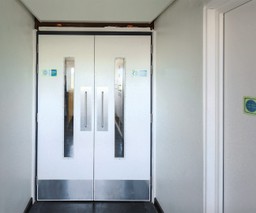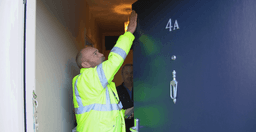Fire Safety in Care Homes: Regulations and Best Practices
Ensuring fire safety in care homes is a responsibility that cannot be taken lightly. Care homes house some of the most vulnerable people in society, including those with limited mobility, cognitive impairments, or other health conditions that may slow down evacuation. At Gerda Security, we specialise in providing high-quality fire safety solutions designed specifically for… Continue reading Fire Safety in Care Homes: Regulations and Best Practices
Ensuring fire safety in care homes is a responsibility that cannot be taken lightly. Care homes house some of the most vulnerable people in society, including those with limited mobility, cognitive impairments, or other health conditions that may slow down evacuation. At Gerda Security, we specialise in providing high-quality fire safety solutions designed specifically for these environments, supporting the safety of residents, staff, and visitors through expert engineering and rigorous compliance with safety standards.
This article covers everything you need to know about fire safety in residential care homes, from essential fire doorset requirements to ongoing maintenance, and how to ensure your care setting is fully protected.
Key Takeaways
- All resident bedrooms in care homes must have self-closing fire doorsets.
- Fire doorsets in care homes should provide at least 60 minutes of fire resistance.
- Regular inspections of fire doorsets are legally required.
- High-performance fire doorsets can combine fire safety with advanced security.
- Fire doorsets play a key role in protecting vulnerable residents during evacuation.
- Maintenance and staff training are critical for long-term fire safety in care settings.
Why Fire Safety in Care Homes Is Essential
Care homes present unique challenges when it comes to fire safety. Unlike typical residential buildings, care settings house individuals who may be unable to quickly exit during an emergency. In the event of a fire, smoke and flames can spread rapidly, and without adequate fire protection measures in place, the results could be devastating.
This is where fire doorsets play an essential role. High-quality fire doorsets contain both fire and smoke, creating a safe barrier that protects residents and provides crucial time for evacuation. In fire safety in care settings, this time is critical, and even minutes can save lives.
To maintain safety in these settings, care homes must meet strict regulations and standards, and this starts with understanding the legal requirements.
Legal Requirements for Fire Doorsets in Residential Care Homes
In the UK, regulations around fire safety in care homes are clear. For care homes to comply with legal standards and keep residents safe, several measures must be followed.
First, every resident bedroom must be fitted with a self-closing fire doorset. This ensures that even if a fire starts within a bedroom, the door will close automatically to contain the flames and smoke.
Second, the fire doorsets must typically be rated to resist fire and smoke for at least 60 minutes. This FD60(S) standard offers crucial protection, although specific areas of the building may require different ratings based on a full fire risk assessment.
In addition to these ratings, fire doorsets in care homes must include fire and smoke seals in the door or frame. These seals expand when exposed to heat, blocking gaps where dangerous smoke or flames could otherwise pass through. Overhead door closers are also a requirement to guarantee that the doors shut securely every time.
To learn more about these requirements, you can read more about residential fire doors here.
Where Should Fire Doorsets Be Installed in Care Homes?
Fire doorsets are not just for bedrooms. To ensure complete fire safety in care settings, care homes need fire doorsets installed in key locations across the building. These include:
- Escape routes: Stairwells and corridors must be protected, as these are the primary paths for evacuation.
- High-risk areas: Kitchens, boiler rooms, and other areas where fires are more likely to start must have extra protection.
- Communal spaces: Lounges, dining rooms, and other shared areas where many people gather should have appropriate fire containment.
- Secure rooms: Medication storage areas and similar rooms with sensitive materials need fire doorset protection.
Correct placement of fire doorsets creates compartments within the building, slowing the spread of fire and allowing more time for help to arrive.
To learn how these doors function in social housing and similar environments, you can learn how we approach residential projects here.
The Safer Homes Range: Setting the Standard for Fire Safety in Care Homes
At Gerda Security, we have developed the Safer Homes Range FD60(S) Internal Flat Entrance Doorsets to meet the highest standards of safety, security, and durability. While these doorsets are designed primarily for residential flats, their advanced features make them an ideal solution for enhancing fire safety in residential care homes and similar environments where vulnerable individuals reside.
Exceptional Fire Resistance
The Safer Homes Range is purpose-built to withstand extreme conditions. Doorsets are available rated to FD60(S), meaning they provide 60 minutes of fire resistance while also containing dangerous smoke. These doorsets comply with EN 1634 tests for smoke and fire resistance, giving care home operators confidence that they meet regulatory demands without compromise.
Superior Construction and Hardware
Care homes require solutions that are built to last and perform without failure. Each Safer Homes Range doorset features:
- A 54mm solid hardwood, veneer-faced timber core door leaf for maximum strength.
- A solid hardwood frame designed to resist warping and damage.
- Several choices of door closer including an integrated overhead door closer (ensuring the door quietly returns to its protective closed position after every use).
These components work together to guarantee that, during an emergency, the door performs exactly as it should.
More details on these products can be found in our Safer Homes Range.
The Contemporary Range: Advanced Fire Safety for Modern Care Settings
The Contemporary Range FD60(S) Internal Doorsets from Gerda Security is another option designed to meet the demanding needs of residential care homes and fire safety in care homes.
Superior Fire and Smoke Resistance
The Contemporary Range is classified FD60(S), meaning it provides 60 minutes of fire and smoke resistance, which is essential in helping staff safely evacuate residents during emergencies. With a steel-insulated construction, these doorsets are engineered to withstand extreme heat and pressure, ensuring maximum protection.
Strength and Stability
Unlike standard doors, the Contemporary Range is built to resist bowing over time. The steel surround ensures the door remains stable and operational, even in high-traffic areas like communal corridors and stairwells. This is crucial for fire safety in residential care homes, where daily use is constant and reliability is non-negotiable.
Complete Compliance and Enhanced Features
Each doorset in this range is thoroughly tested to comply with:
- Fire resistance and smoke control standards.
- Acoustic and thermal insulation requirements.
- Enhanced security certifications for protecting vulnerable residents.
Like all Gerda Security doorsets, the Contemporary Range integrates G-Smart technology, supporting accurate tracking through survey, manufacture, installation, and ongoing maintenance—helping care home managers keep on top of their legal safety obligations.
You can learn more about this option on our Contemporary Range page.
Maintaining Fire Doorsets in Residential Care Homes
Regular inspections and maintenance are essential for fire safety in residential care homes – and this is a regulatory standard.
Inspection Schedule:
- Visual inspections every three months.
- Functionality checks by a Competent Person every six months.
- Full annual inspections by a qualified inspector.
Regular checks ensure that all seals, hinges, and closers are functioning correctly, and that no damage or wear has compromised the door’s ability to protect residents.
Security Features and Customisation
While safety is the priority, appearance and security are also important in fire safety in care settings. Care home environments often feel more comfortable when doors match interior aesthetics. Gerda Security offers a selection of finishes within each doorset range.
At the same time, security features such as anti-bump locks, metal security keeps, and reinforced hinges provide added peace of mind, ensuring that care homes remain secure as well as safe.
Frequently Asked Questions
How long should fire doorsets last in a care home?
In terms of fire resistance, FD60(S) doorsets, which can withstand fire and seal smoke for an hour, are recommended for use in care settings.
As for durability, with proper maintenance, fire doorsets can last over 10 years. Regular inspections are essential to ensure ongoing compliance.
Can fire doorsets stay open during the day?
It is recommended for fire doorsets to remain closed, and they are equipped with closers to make this as easy as possible. However, they can be left open if they use certified retainers – which release automatically when the fire alarm sounds.
How do I know if my fire doorsets meet regulations?
Check for certification labels, and ensure regular inspections are carried out by professionals. If you are a resident, you can talk to your building’s responsible person for more information.



